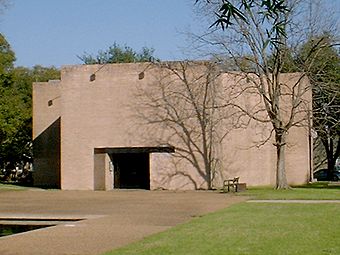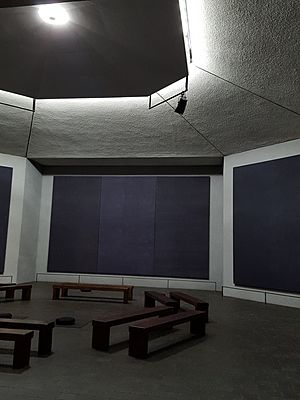Rothko Chapel facts for kids
Quick facts for kids |
|
|
Rothko Chapel
|
|
 |
|
| Location | 3900 Yupon Street, Houston, Texas |
|---|---|
| Area | less than 1 acre (4,000 m2) |
| Built | 1971 |
| Architect | Rothko, Mark; Johnson, Philip, et al. Renovation (2020) by Architecture Research Office. |
| Architectural style | Modern Movement, New Formalist |
| NRHP reference No. | 00000883 |
| Added to NRHP | August 16, 2000 |
The Rothko Chapel is a special building in Houston, Texas. It was created by John and Dominique de Menil. This chapel is unique because it's not tied to any single religion. It's a place where people from all backgrounds can come to think, pray, or simply be quiet.
Inside, the chapel is also an art gallery. Its walls display fourteen large paintings by the famous artist Mark Rothko. These paintings use different shades of black and other dark colors. Rothko himself had a big influence on how the building looks. The chapel is shaped like an octagon, which is an eight-sided figure.
The Rothko Chapel is located near the Menil Collection museum and the University of Saint Thomas. About 110,000 people visit this peaceful place every year. It's known as a global center for different cultures and religions to come together. It also hosts discussions and performances. In 2000, the chapel was added to the National Register of Historic Places, recognizing its importance.
Contents
A Look at the Chapel's Past
How the Chapel Began
In 1964, John and Dominique de Menil asked Mark Rothko to create a calm space filled with his art. Rothko's paintings were made specifically for this building. He worked closely on the chapel's design. Rothko had some disagreements with the first architect, Philip Johnson. The plans changed several times, and other architects like Howard Barnstone and Eugene Aubry joined the project. Sadly, Rothko passed away in 1970, so he never saw the chapel finished in 1971.
A Place for Justice and Freedom
Starting in 1973, the Rothko Chapel became more than just a chapel. It also served as a meeting place for discussions about justice and freedom around the world. Scholars from many countries came together to share ideas.
In 1981, the chapel started giving out "The Rothko Chapel Awards to Commitment to Truth and Freedom." Later, another award was created to honor Óscar Romero. These awards recognize people and groups who bravely speak out against human rights violations. In 1991, Nelson Mandela received a special Rothko Chapel award.
Keeping the Chapel Beautiful
The chapel has been carefully maintained over the years. In 1999, it closed for a big renovation. The paintings were showing signs of age and needed special care. In 2000, the chapel reopened after an 18-month, $1.8 million renovation. The paintings looked new again.
In May 2018, the chapel was vandalized. White paint was spilled near the entrance and in the reflecting pool. Flyers were also left around the grounds.
For its 50th anniversary in 2021, the Rothko Chapel had another major restoration. This $30 million project made the chapel look even closer to its original design. They updated the skylight and improved the surrounding gardens. A new visitor's center was also added.
In July 2024, Hurricane Beryl caused damage to the chapel. Three of Rothko's paintings, along with the ceiling and walls, were affected. The chapel closed for repairs in August 2024. It reopened in December 2024 after all the restoration work was completed.
The Chapel's Design
The Rothko Chapel is an eight-sided building made of brick. It has gray or rose-colored walls and a skylight. It's a quiet place for thinking and also a meeting hall. Inside, there are simple, movable benches for visitors. Holy books from different religions are available for anyone to read.
During the 2020 renovation, a new skylight was installed. It has 280 special aluminum blades. These blades are angled to spread light evenly onto the paintings on the walls. This helps to show off the artwork perfectly.
Amazing Art at the Chapel
The Rothko Chapel is home to several important works of art, including paintings, a sculpture, and even music.
Rothko's Paintings
Fourteen of Mark Rothko's large paintings are displayed inside the chapel. Three of the walls have sets of three paintings, called triptychs. The other five walls each have a single painting. Rothko started creating these dark, black paintings in 1964. They use different dark colors and textures.
The de Menils asked Rothko to create these paintings for the chapel in 1964. From 1964 to 1967, he painted the fourteen main artworks and four extra ones. These paintings share many features with his earlier dark works.
The Broken Obelisk Sculpture

Outside the chapel, you'll find a striking sculpture called Broken Obelisk by Barnett Newman. It was placed there in 1970. The sculpture stands in a reflecting pool designed by Philip Johnson. It is dedicated to the memory of Martin Luther King Jr., who was assassinated in 1968.
This sculpture was first in Washington, D.C.. In 1969, the de Menils offered it to Houston City Hall as a memorial to King. When Houston declined, the de Menils decided to donate the sculpture and Rothko's paintings to start the Rothko Chapel.
Music Inspired by the Chapel
The Rothko Chapel has inspired many musicians. One of Morton Feldman's most famous pieces, also called Rothko Chapel (1971), was written to be performed there. The musician Peter Gabriel wrote a song called "Fourteen Black Paintings" in 1992 after visiting the chapel. David Dondero also composed a song titled "Rothko Chapel" for his 2007 album Simple Love.
In 1986, Tibetan monks performed special harmonic chanting at the chapel. In 2017, an opera about the chapel called Some Light Emerges premiered. More recently, Solange Knowles filmed parts of her visual album When I Get Home in the chapel in 2019. Dessa's 2023 album Bury the Lede includes a song called "Rothko," which is set in the chapel.
Awards and Recognition
The Rothko Chapel is known for bringing together leaders in social justice, art, and spirituality. It has received several awards, including the Peace Award from The Houston Baha’í Community (1998) and The James L. Tucker Interfaith Award (2004).
The chapel also hosts the biannual Óscar Romero Award. This award honors people who bravely advocate for human rights at the grassroots level. Past winners include Bishop Proaño and Berta Cáceres.
See also
 In Spanish: Capilla Rothko para niños
In Spanish: Capilla Rothko para niños
- Menil Collection
- Michael Somoroff




